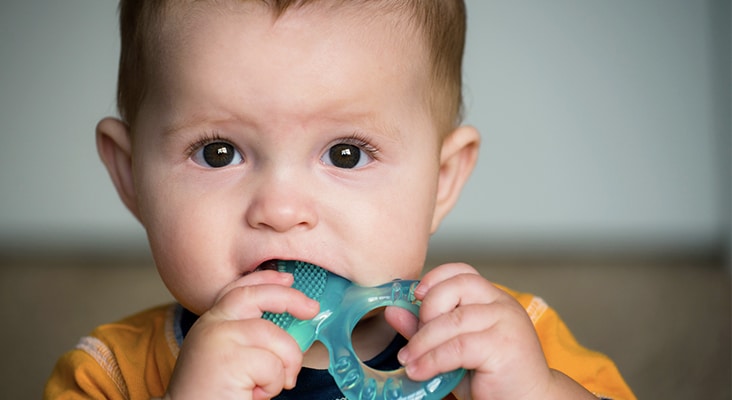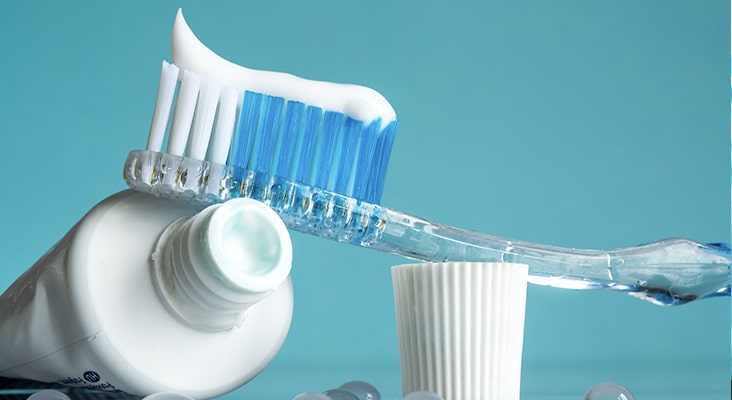Developing Dentition
Vast developmental oral changes occur in children during the first 6 years of life.

Developmental Oral Changes
Vast developmental oral changes occur in children during the first 6 years of life. The amount of education needed to properly care for the primary dentition may seem overwhelming to parents/caregivers. Developing an effective self-care regimen requires a team effort between children, parents/caregivers, and oral health professionals.
Photo Credit: Prostock-Studio / iStock / Getty Images Plus

Teething
In many children, tooth eruption begins around 6 months and can last until age 3, averaging one new tooth every month during this period. Tooth eruption (teething) can bring localized and systemic discomfort, as it is a combination of trauma, inflammation, and healing. During the teething process, immunoregulatory events enable the tooth’s eruption pathway to occur through the bone and gingiva. This complex process involves the release of cytokines, activation of osteoclasts, and diffusion of glycoproteins in the blood. This physiological process triggers an inflammatory immune response, causing pain and fever along with gingival irritation, sleep disturbance, loss of appetite, upset stomach, and irritability. Discomfort associated with teething lasts approximately 8 days per tooth, 4 days prior to tooth eruption and 4 days after.
Photo Credit: ideabug / E+

Alleviate Discomfort
Common methods to alleviate the discomfort caused by teething are chilled teething rings or pacifiers, massaging the gingiva, antipyretics, analgesics, and topical anesthetic agents or teething gels. Recently, the United States Food and Drug Administration (FDA) published guidelines regarding teething gels. The FDA states: “Teething is a normal part of childhood and should not be treated with homeopathic remedies, like teething tablets, or prescription or over-the-counter medications that are rubbed on the gums.” Topical agents generally are quickly washed away by saliva, are ineffective, and potentially hazardous. The current FDA recommendations are particularly important for children younger than 2.
Photo Credit: RobHainer / iStock / Getty Images Plus

Caries Risk
Dental caries is a significant public health concern and the most prevalent chronic disease in children. The ADA defines early childhood caries as the presence of one or more decayed, missing, or filled tooth surfaces in any primary tooth in children between birth to age 6. Prevention strategies must start as soon as the first tooth erupts. Parents/caregivers may wrongly believe that decay in the primary dentition ends when the teeth are shed. While caries is an infectious, transmissible disease, when managed properly, it can be effectively prevented and possibly arrested. Implementing effective preventive strategies may prevent the need for lifelong and invasive intervention. Extensive decay in young children may require surgery and general anesthesia. Rates of retreatment for dental caries that require general anesthesia are high (50%). Parents/caregivers need to be informed about the etiology of caries and preventive strategies, such as fluoride, plaque control, and diet modifications. Caries risk assessment should also be part of every pediatric dental appointment.
Photo Credit: istmylisa / iStock / Getty Images Plus

Oral Hygiene
Biofilm control is a major contributor in caries prevention. Primarily, biofilm control should be initiated at home. To clean an infant’s mouth, parents/caregivers can use a soft wash cloth to gently wipe the gingiva. Toothbrushing with a soft brush should start as soon as the first tooth erupts. Parents/caregivers should assist their children with brushing twice daily and flossing closed contacts daily until age 3. The AAPD recommends supervising oral hygiene twice daily until the child is at least 8. A general rule is once children gain enough dexterity to tie their own shoes, they are most likely able to independently brush their teeth. Demonstrating brushing technique is critical for patients and parents/caregivers. Caregivers value practical tips and demonstration of proper technique over the mere transmission of information.
Photo Credit: FamVeld / iStock / Getty Images Plus

Fluoride
For additional caries prevention, fluoride toothpaste should be used, starting with a small smear or the size of a rice grain from ages 0 to 2. The amount of toothpaste can be increased to a pea-sized amount from ages 3 to 6. Children older than 6 may use a 0.05% sodium fluoride mouthrinse on a daily basis to decrease caries risk. Fluoride mouthrinse is not recommended for children younger than 6, due to the risk of fluorosis if repeatedly swallowed. Professional application of topical fluoride can begin with tooth eruption for children at elevated caries risk. For children younger than 6, only fluoride varnish is recommended. For children age 6 and older, both fluoride varnish and acidulated phosphate fluoride (APF) gel are recommended for caries prevention. The professional application of silver diamine fluoride (SDF) can arrest carious lesions. It has also shown efficacy in preventing caries in tooth surfaces adjacent to carious lesions. However, it causes tooth staining; this side effect must be fully explained to patients and their parents/caregivers. The systemic use of fluoride is also effective in reducing tooth decay. Optimally fluoridated community water supplies can reduce caries rates by 20% to 40%.
Photo Credit: Antonistock / iStock / Getty Images Plus

Sealants
The use of sealants is a well-documented caries prevention measure in the pits and fissures of posterior teeth. Approximately 90% of carious lesions present on posterior teeth. A recent Cochrane Review reports sealants produce an 11% to 51% reduction in occlusal caries compared with no sealant application. Pits and fissures require supplementary intervention to prevent biofilm retention as the tooth’s morphology creates anatomical spaces that retain biofilm. Sealants should be applied soon after tooth eruption to increase efficacy. Retention should be evaluated at each hygiene visit as retention rates decrease over time.

